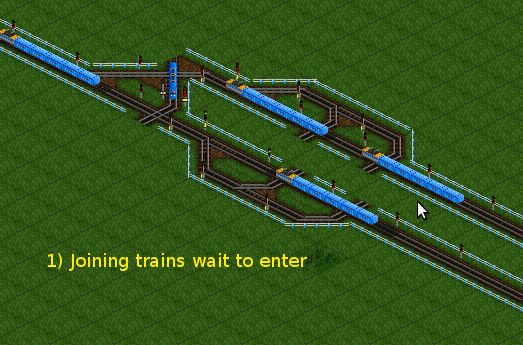Difference between revisions of "Two-way Prio"
From #openttdcoop wiki
(Created page with 'A standard prio gives priority to trains on the mainline and makes trains on the sideline way. In some join, especially at BBHs, a prio may build up long queues waiting to enter …') |
|||
| Line 1: | Line 1: | ||
| − | A standard prio gives priority to trains on the mainline and makes trains on the sideline way. In some join, especially at BBHs, a prio may build up long queues waiting to enter the mainline. On PSG 178, we experimented with a concept named a Two-way Prio. The basic idea is that when the waiting trains begin to roll, they should keep rolling and not stop for a few trains on the ML. | + | A standard prio gives priority to trains on the mainline and makes trains on the sideline way. In some join, especially at BBHs, a prio may build up long queues waiting to enter the mainline. On PSG 178, we experimented with a concept named a Two-way Prio. The basic idea is that when the waiting trains begin to roll, they should keep rolling and not stop for a few trains on the ML. The mechanism is similar to a real-life traffic light. It releases all traffic in one direction and then switches to the other direction and releases all traffic from there (although, the Two-way prio does not have a timeout, like traffic lights). |
| + | |||
| + | [[File:twowayprio.gif]] | ||
| + | |||
| + | A place to use this is in BBHs where neither of the MLs is more major than the other. A simple join will leave huge gaps, and a standard prio may build big queues even with good balancing. | ||
Revision as of 20:07, 14 March 2010
A standard prio gives priority to trains on the mainline and makes trains on the sideline way. In some join, especially at BBHs, a prio may build up long queues waiting to enter the mainline. On PSG 178, we experimented with a concept named a Two-way Prio. The basic idea is that when the waiting trains begin to roll, they should keep rolling and not stop for a few trains on the ML. The mechanism is similar to a real-life traffic light. It releases all traffic in one direction and then switches to the other direction and releases all traffic from there (although, the Two-way prio does not have a timeout, like traffic lights).
A place to use this is in BBHs where neither of the MLs is more major than the other. A simple join will leave huge gaps, and a standard prio may build big queues even with good balancing.
